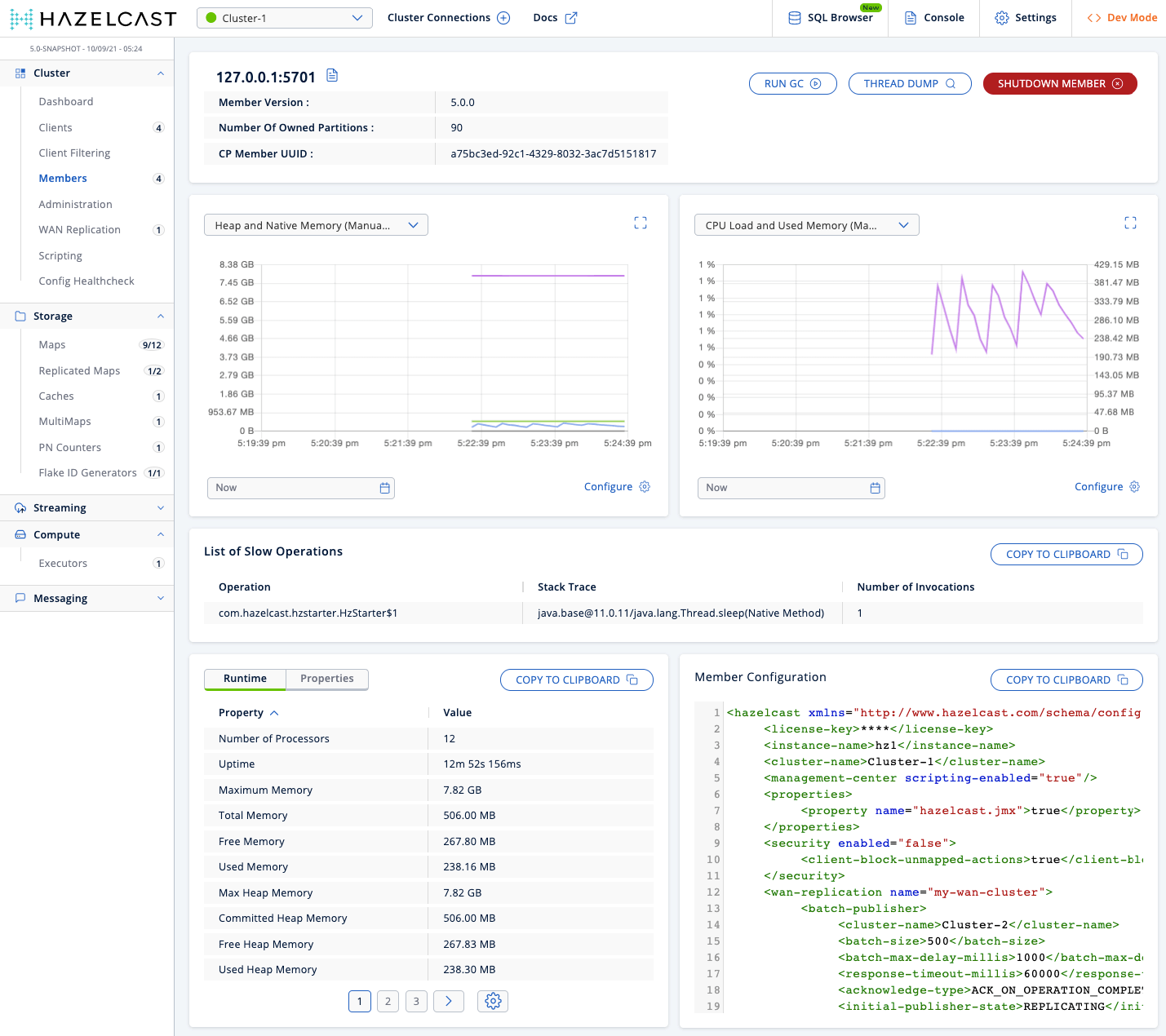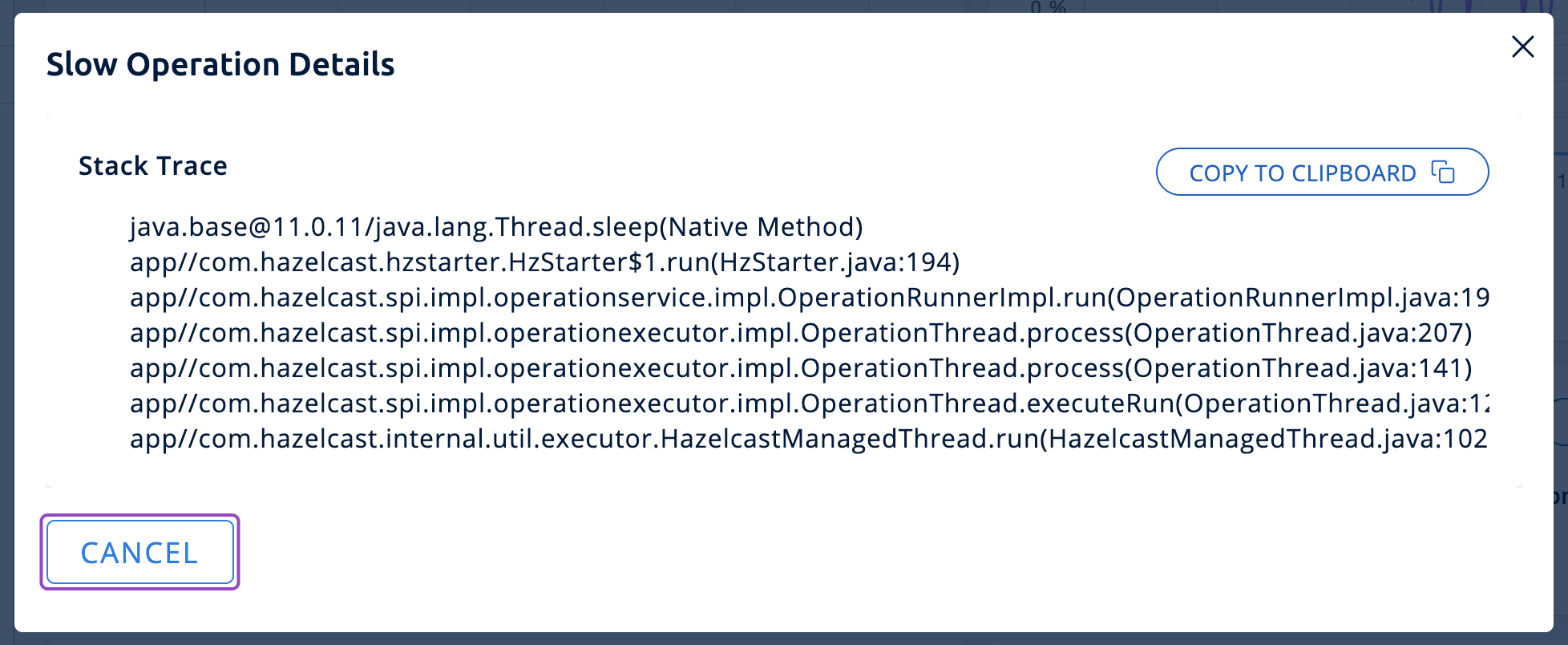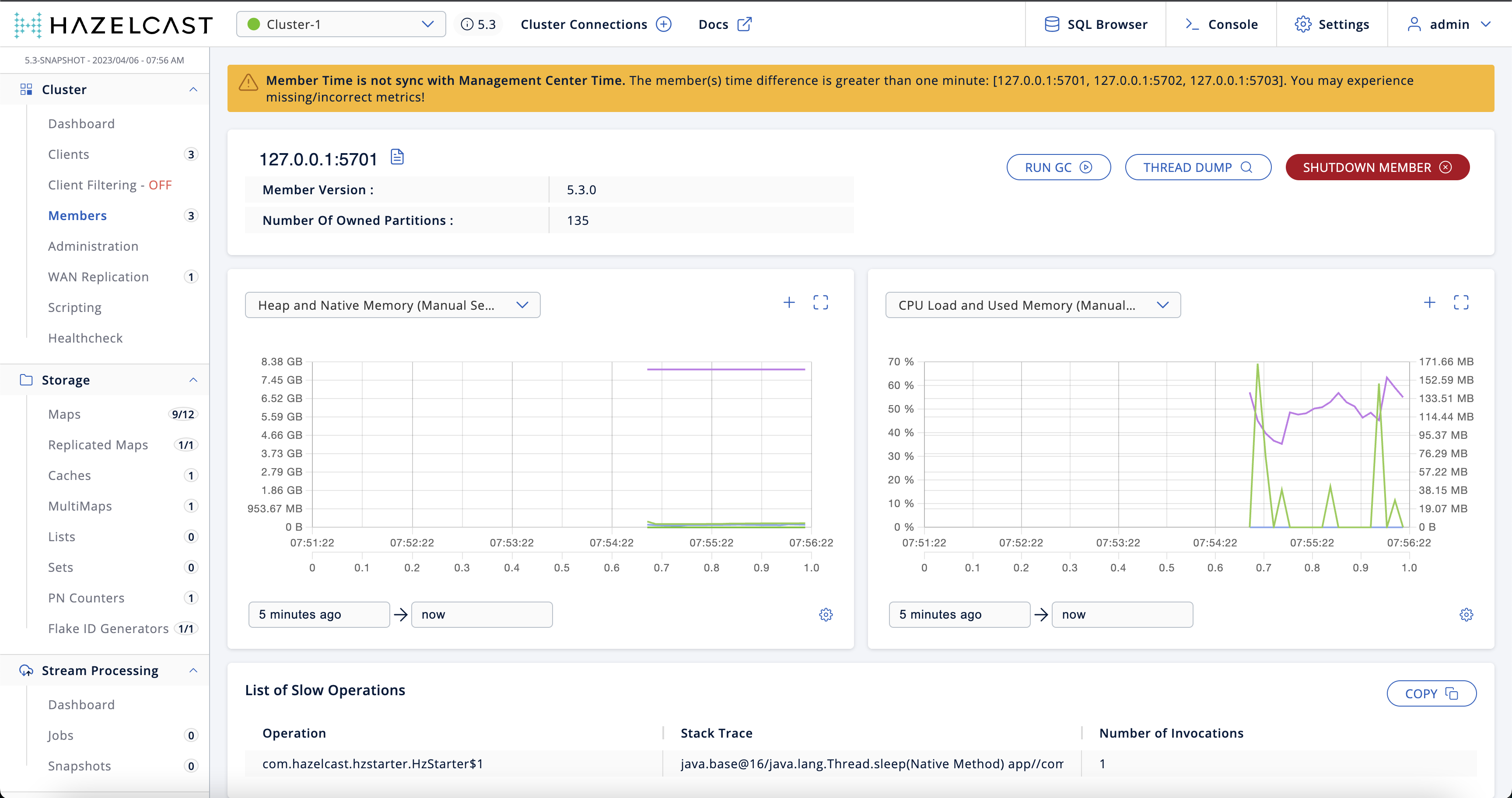You can use the Members menu item to monitor each member in a cluster and perform management operations on any member such as running garbage collection (GC), taking a thread dump, and shutting it down.

| Field | Description |
|---|---|
Member |
The IP address and port of the member. |
Additional Info |
Displays an info icon if the member is a CP member or a warning icon if the member’s runtime or hardware setup does not conform to our production recommendations. Hover over the icon to see the tooltip. For a list of production recommendations, see Production Checklist in the Platform documentation. To monitor and manage the CP subsystem, see CP Subsystem. |
Scripting |
Whether scripting is enabled. See Scripting |
Streaming |
Whether the Jet engine is enabled. See Configuring the Jet Engine in the Platform documentation. |
Slow Operations |
Whether the member has detected slow operations. See Slow Operations on this page. |
Hazelcast Version |
Version of the member codebase that the member is running. |
Owned Partitions |
Number of partitions that are owned by the member. |
OS Total Physical Memory |
Total amount of physical memory on the member. |
OS Committed Virtual Memory |
Amount of virtual memory that is guaranteed to be available to the running member. |
OS Free Physical Memory |
Amount of free physical memory on the member. |
OS CPU Load |
Recent CPU usage for the whole system represented as a percentage value.
0% means that all CPUs were idle during the recent period of time
observed, while |
OS Max File Desc |
Maximum number of file descriptors. File descriptor is an integer number that uniquely represents an opened file in the operating system. |
OS Open File Desc |
Number of open file descriptors. |
Filtering Members
To filter the displayed members, use the Search bar in the right-hand corner.
To sort the table, click on the column headers.
Viewing Details about a Member
To see more details about a particular member, click on the member’s row in the table.

Actions
On each member, you can trigger the following actions:
-
Run GC: Executes garbage collection on the selected member. A notification stating that the GC execution was successful is shown.
-
Thread Dump: Takes a thread dump of the selected member and shows it in a separate dialog.
-
Shutdown Member: Shuts down the selected member.
-
Promote Member: If the member is a lite member, this button promotes it to a data member.
Graphs
The Heap and Native Memory chart shows the percentage
of CPU usage on the selected member. The CPU Load and Used Memory chart shows the memory usage on the
selected member. You can open
each chart as a separate dialog using
the maximize  button.
button.
To customize the data displayed in the graphs, see Graphs
Runtime
Runtime is a dynamically updated window tab showing the processor number, the start and up times, and the maximum, total and free memory sizes of the selected member. These values are collected from the default MXBeans in the Java Virtual Machine (JVM).
| These descriptions may vary according to the JVM version or vendor. |
| Field | Description |
|---|---|
Number of Processors |
Number of processors available to the member (JVM). |
Start Time |
Start time of the member (JVM). |
Uptime |
Uptime of the member (JVM). |
Maximum Memory |
Maximum amount of memory that the member (JVM) will attempt to use. |
Free Memory |
Amount of free memory in the member (JVM). |
Used Heap Memory |
Amount of used memory. |
Max Heap Memory |
Maximum amount of memory that can be used for memory management. |
Used Non-Heap Memory |
Amount of used memory. |
Max Non-Heap Memory |
Maximum amount of memory that can be used for memory management. |
Total Loaded Classes |
Total number of classes that have been loaded since the member (JVM) has started execution. |
Current Loaded Classes |
Number of classes that are currently loaded in the member (JVM). |
Total Unloaded Classes |
Total number of classes unloaded since the member (JVM) has started execution. |
Total Thread Count |
Total number of threads created and also started since the member (JVM) started. |
Active Thread Count |
Current number of live threads including both daemon and non-daemon threads. |
Peak Thread Count |
Peak live thread count since the member (JVM) started or peak was reset. |
Daemon Thread Count |
Current number of live daemon threads. |
OS Free Physical Memory |
Amount of free physical memory. |
OS Committed Virtual Memory |
Amount of virtual memory that is guaranteed to be available to the running process. |
OS Total Physical Memory |
Total amount of physical memory. |
OS Free Swap Space |
Amount of free swap space. Swap space is used when the amount of physical memory (RAM) is full. If the system needs more memory resources and the RAM is full, inactive pages in memory are moved to the swap space. |
OS Total Swap Space |
Total amount of swap space. |
OS Maximum File Descriptor Count |
Maximum number of file descriptors. File descriptor is an integer number that uniquely represents an opened file in the operating system. |
OS Open File Descriptor Count |
Number of open file descriptors. |
OS Process CPU Time |
CPU time used by the process on which the member (JVM) is running. |
OS Process CPU Load |
Recent CPU usage for the member (JVM) process. This is a double with a value from 0.0 to 1.0. A value of 0.0 means that none of the CPUs were running threads from the member (JVM) process during the recent period of time observed, while a value of 1.0 means that all CPUs were actively running threads from the member (JVM) 100% of the time during the recent period being observed. Threads from the member (JVM) include the application threads as well as the member (JVM) internal threads. |
OS System Load Average |
System load average for the last minute. The system load average is the average over a period of time of this sum: (the number of runnable entities queued to the available processors) + (the number of runnable entities running on the available processors). The way in which the load average is calculated is operating system specific but it is typically a damped time-dependent average. |
OS System CPU Load |
Recent CPU usage for the whole system represented as a percentage value. 0% means that all CPUs were idle during the recent period of time observed, while 100% means that all CPUs were actively running during the recent period being observed. |
Member Configuration
Management Center receives the member configuration in XML format. As a result, even if you used a different configuration format such as YAML, it will be displayed in XML.
To view a member’s configuration:
-
Click a member’s row in the table.
-
Scroll down to Member Configuration at the bottom of the page.
Slow Operations
If a member has slow operations, you can view the detected slow operations which occurred on that member. The data is collected by the SlowOperationDetector.
To view slow operations for a member:
-
Click a member’s row in the table.
-
Click on an entry in the List of Slow Operations table.

Clock Synchronization
Any time difference greater than one minute between the Management Center and a member can cause synchronization issues, delayed responses or data loss. To prevent such issues, Management Center would report the members that have such time differences to the user.
You can view the detected members in the warning notification that is positioned just below the top bar.

It is highly recommended to synchronize the Management Center JVM clock with the clocks of the members in the cluster to ensure consistent time. Clock synchronization can help to promote optimal performance and proper communication.
